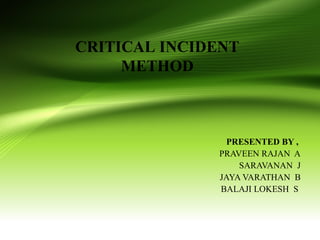
Critical incident method_hrm_appraisal
- 1. PRESENTED BY , PRAVEEN RAJAN A SARAVANAN J JAYA VARATHAN B BALAJI LOKESH S CRITICAL INCIDENT METHOD
- 2. Topics Presented under critical incident method Introduction Definition Characteristics Guidelines for Collect Data Method used to collect Data Applications Advantage and Disadvantage
- 3. INTRODUCTION Earlier , this method was used for job analysis developed by Flanagan in 1950. Later this method of performance appraisal was developed by Flanagan and Burns in the year of 1955. They proposed 3 steps in this method , (1) Completing the performance record as critical incidents occur. (2) Summarizing them for the rating period. (3) Conducting performance review interview with the employee.
- 4. DEFINITION The critical incident method of performance appraisal involved identifying and describing specific events (or incidents) where the employee did something really well or something that needs improvement. It's a technique based on the description of the event,and does not rely on the assignment of ratings or rankings, although it is occasionally coupled with a ratings type system.
- 5. CHARACTERISTICS Specific Focus on observable behaviours on the job Describe the content in which the behaviour occurred Indicate the outcomes
- 6. GUIDELINES FOR COLLECTING DATA To ask right question. Keep the question simple and direct. In survey and focus group method, don't ask employee to attach their name.
- 7. METHOD USED TO COLLECT DATA Focus Groups Interviews Surveys Performance Records Work Diaries
- 8. APPLICATION Performance and Cause Analysis Organizational Development Evaluation Performance Management Competency Modeling Competency Assessment
- 9. ADVANTAGE Critical incidents provide dramatic demonstrations of the impact of behavior. Does not force the respondents into any given framework. Flexible method. They are easy and economical to develop and administer. Critical incidents can measure abstract constructs such as motivation through their demonstration in reported behavior. When the data are collected through an anonymous survey approach, protecting their identity.
- 10. DISADVANTAGE In critical incidents, reports of behavior are filtered through the lenses of individuals’ perceptions, memory,honesty and biases, and therefore may not be entirely accurate. It can be time-consuming and laborious to summarize and analyze the data. Negative incidents may be more noticeable than positive incidents. It results in very close supervision which may not be liked by the employee. The recording of incidents may be a chore for the manager concerned, who may be too busy or forget to do it .